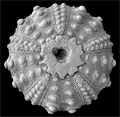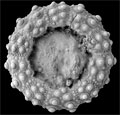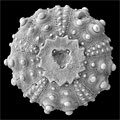The Echinoid Directory
Contributed by Andrew Smith, June 2009
Goniopygus whitneyi Smith & Rader, 2009, p. 28
[1987 Goniopygus guadalupae Akers & Akers, p. 57 (nomen nudum)]
| Diagnostic Features |
A species of Goniopygus with a smooth, unornamented, flat-topped apical disc; the circular periproct surrounded by a trigonal depressed zone. Small but well developed, sunken perianal tubercles on genital plates 1, 3, 5, and sometimes with a smaller tubercle also on genital plates 2 and 4. Genital plate 2 with hydropores scattered in two depressed zones symmetrically on either side of the interradial point. Ambulacra with primary tubercles only, which are more or less contiguous along perradius. Primary interambulacral tubercles reducing in size only gradually above the ambitus.
|
|---|---|
| Distribution | Glen Rose Formation, Early Albian, Texas, USA. |
| Type | Holotype, Natural History Museum London EE13382; paratypes EE13383-97
|
| Classification and/or Status | A species of Goniopygus |
| Remarks | This species is easily distinguished from the contemporary G. delphinense of Europe by its ambulacral tuberculation: in G. whitneyi the primary ambulacral tubercles are more or less contiguous down the perradius, whereas in G. delphinense of a similar size there is a well developed inner column of secondary tubercles on ambital and adapical plates. It further differs in the distinctive shape of genital plate 2, which in G. whitneyi has lateral depressions bordering a tapering distal ridge, something that is never seen in G. delphinense. Its completely smooth and pit-free apical disc and well-developed U-shaped depressions on genital plates 1, 3 and 5 separates this species from G. loryi and G. pelatus. G. zitteli Clark, from the Upper Albian Edwards Limestone of Texas is also easily distinguished from this species as it has much more pointed genital plates and each genital plate bears a mammillated perianal tubercle.
G. whitneyi comes closest to G. menardi from the late Albian and Cenomanian of Europe and North Africa. Both have a similar flat and unornamented apical disc, and the ambulacral plates bear only a single column of primary tubercles. Furthermore small but obvious secondary tubercles are scattered around the primary tubercles on plates at the ambitus and below, but are replaced by fine granules only on the adapical plates. G. whitneyi is distinguished however, in having distinctly larger and coarser interambulacral tubercles above the ambitus. In G. menardi at a similar size the largest primary tubercles occur at or very slightly above the ambitus and adapical tubercles reduce in size significantly. In G. whitneyi the largest tubercle occurs distinctly above the ambitus and tubercles become smaller more gradually towards the apical disc. When compared side-by-side G. whitneyi has a distinctly coarser tuberculation than G. menardi. Smith, A. B. & Rader, B. 2009. Echinoid diversity, preservation potential and sequence stratigraphical cycles in the Glen Rose Formation (early Albian, Early Cretaceous), Texas, USA. Palaeodiversity and Palaeoenvironments 89, 7-52. |




